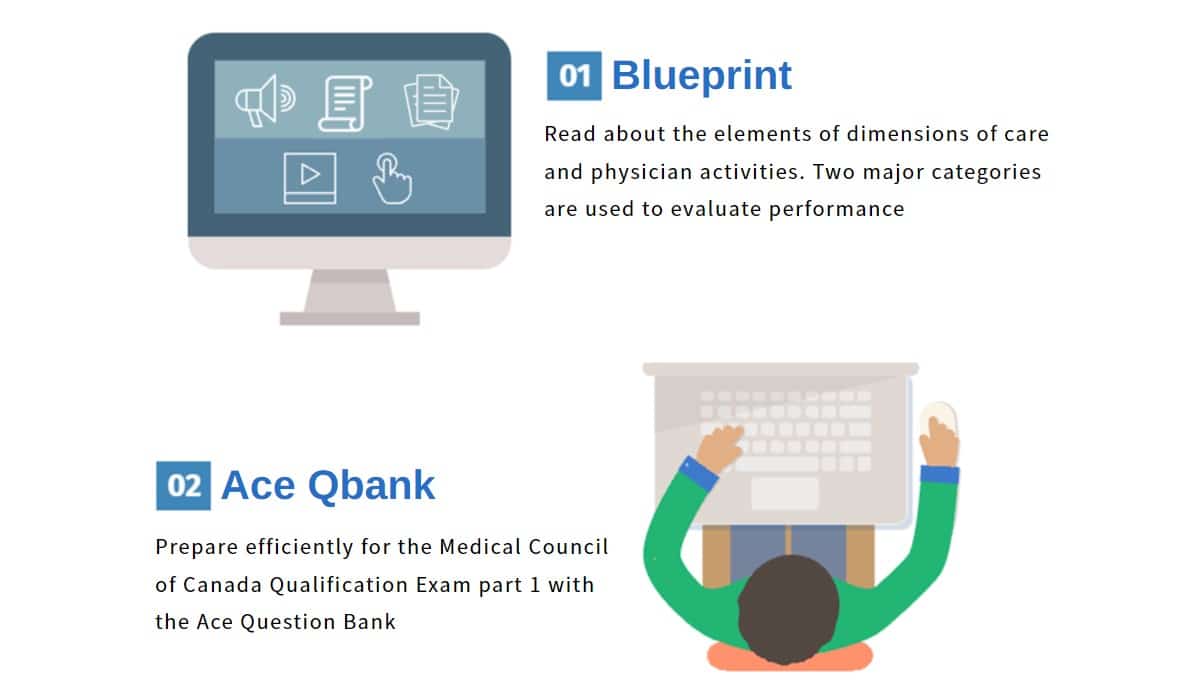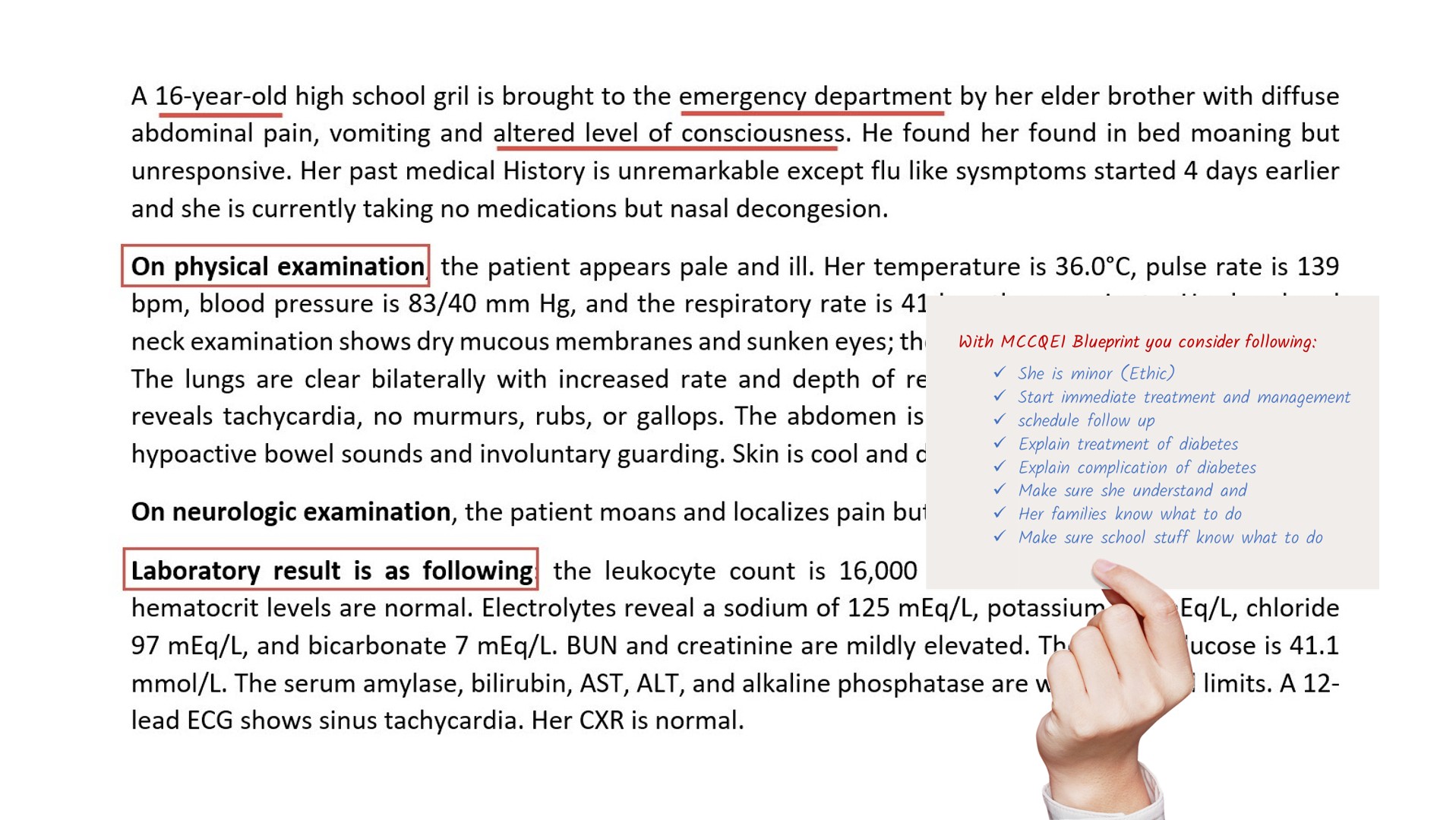How to Ace the MCCQE1 exam using the blueprint

The Medical Council of Canada Qualifying Examination (MCCQE) Part 1 exam is a licensure exam that is administered by the Medical Council of Canada (MCC) and is probably one of the most difficult to pass of the many certification exams offered by the Medical Council of Canada (MCC). It is also considered to be an important exam for practicing physicians, as passing the exam is a requirement before applying for the residency program.
The MCCQE Part 1 evaluates a candidate’s critical medical knowledge and clinical decision-making skills at the level of a Canadian medical student or a medical school graduate. The exam consists of a combination of multiple-choice questions, written answers, and a test of clinical reasoning. You can take the exam in one sitting. The MCCQE 1 exam format has two parts, each lasting for 4 hours and consisting of 210 multiple-choice questions, followed by 38 clinical cases with short-menu and short-answer write-in questions. The exam requires you to have a solid understanding of the MCC objectives that will be tested, and your performance is assessed based on two categories: dimensions of care and physician activities.
Despite the fact that the MCCQE1 exam is a difficult exam, many candidates who know and are familiar with the MCCQE1 blueprint pass the exam on the first attempt. However, there are unfortunate physicians who fail the MCCQE1 exam despite all their hard work. This blog post will cover:
- What exactly is the MCCQE1 blueprint about?
- What are the dimensions of care and the actions of physicians?
- How does the blueprint assist in MCCQE1 preparation?
To help you prepare properly for the MCCQE1 exam and, in the end, discuss how to use the blueprint to your advantage.
Why is the MCCQE1 blueprint so important?
MCC created the MCCQE1 exam to assess medical knowledge and clinical decision-making that is taught in medical school and practiced on a daily basis. Passing the MCCQE1 exam will require you to go through the MCC objectives list, master those objectives, and then work on test-taking strategies and skills such as time management. Knowing MCC objectives is half the battle; the other half is answering multiple questions correctly in one minute while also knowing when to move on to the next question. It sounds simple, doesn’t it?
Create a random set of 40 questions in the Ace Qbank’s time mode and try to answer them all before the time runs out!!
Yes, I know. The problem is that you can’t know how it really feels, and it is impossible to know what it’s really like until you experience it. Your experience was in the comfort of your own home; imagine how that would be under exam-stress. The good news is that it is possible and doable to answer all questions in a minute but will require patience and a lot of practice.
MCCQE1 blueprint, on the other hand, helps you to focus on what’s essential throughout your MCCQE1 exam preparation. The blueprint helps you see the cross-path in healthcare so keep it in mind while diagnosing and managing patients. During the exam preparation, knowing about the blueprint will help you focus on those similarities and differences between certain medical conditions, differential diagnoses, and distinctive key points, along with ethical challenges, which will come in handy while selecting the correct answer for MCQs or excluding options. The MCCQE1 blueprint is the light in the darkness; without it, preparing for the MCCQE1 exam is an uphill battle.
Basically, the MCCQE1 blueprint is about the fundamental core abilities required of doctors practicing in Canada at various stages of their careers and has two major categories: dimensions of care and physician activities. The dimensions of care are assessment, which provides the full spectrum of medical care, and physician activities reflect a physician’s scope of practice. On the MCCQE1 exam, the performance of candidates is assessed based on two major categories.
At this point, you might be wondering what the MCCQE1 blueprint has to do with MCCQE1 exam preparation. The Multiple Choice Questions (MCQs) and CDM cases are meant to assess medical knowledge and skills on one end and tailored based on the MCCQE1 blueprint to assess the quality of dimension of care and physician activities on the other. As a result, a candidate who passes the MCCQE1 exam has medical knowledge, skill, and familiarity with Canadian health care, as well as an understanding of what is expected of a Canadian physician.
On the flip side, the blueprint is an excellent guide for any physician who wants to prepare for the MCCQE1 exam. It is essential for you to prepare with the blueprint if you wish to succeed on your exam. It helps you understand what to expect on the exam and how to prepare properly.
You may, however, kill two birds with one stone by using the Ace Qbank. The only Canada question bank that designed questions based on MCC objectives offers time and tutor modes and is focused on high-yield, essential and need-to-know concepts. Additionally, Ace Qbank provides self-assessments, so you can track your progress. The greatest part is that the questions are unique and different from the main question bank, which improves the accuracy of the assessment. Ace Qbank is essentially a one-stop shop for preparing for the MCCQE1 exam.

What are the Dimensions of Care?
As the health care system evolves, it is imperative to understand the concept behind the Dimensions of Care (DOC). The DOC is a set of interrelated core concepts that capture the broadest understanding of healthcare and its delivery across the continuum of care. In other words, DOCs help capture the “whole picture” of how healthcare is delivered to patients. The Dimensions of Care include health promotion and prevention, acute, chronic, and psychosocial aspects. Each of these dimensions is important to consider when assessing the health and wellbeing of a person and when determining the appropriate treatment and care for a patient, or even when trying to answer a broad question.
Acute:
A brief episode of illness, this dimension includes urgent, emergent, and life-threatening conditions, new conditions, and exacerbation of underlying conditions.
Chronic:
Complications resulting from a prolonged illness.
Psychosocial Aspects:
Has root in the social and psychological determinants of health and how these can impact wellbeing or illness. The determinants include life challenges, income, culture, and the impact of the patient’s social and physical environment.
Health Promotion and Illness Prevention:
The process of enabling individuals to gain more control over their health and, as a result, improve their health. Disease prevention includes efforts to avoid the onset of illness, such as risk factor reduction and actions to stop its progression and decrease its effects after it has occurred. Screening, periodic health checks, health maintenance, and patient education are all part of it.

What are the Physician activities?
Physician activities talk about the nature of a physician’s roles in practice and reflect a physician’s scope of practice. It includes diagnosis, management, communication, and professional behaviors, with communication becoming the important aspect of physician activities.
Over the past few years, the ability to communicate effectively with patients, colleagues, and professionals has risen in popularity in all areas of physician practice, but COVID-19 pandemic and telemedicine have given communication the center stage. Emphasis on the prevention of preventable health care, communication between the patient and the healthcare provider, and professional behaviors have been increased and are reaching the level of diagnosis, management, and treatment.
Diagnosis:
Exploration of disease utilizing clinical judgment to collect, evaluate, and integrate the pertinent information, including physical examination and investigation.
Management:
Establishing common ground, deciding on goals and problems, managing time and resources, collaborating on treatment decisions, and working as a team in collaboration with patients, families, and communities to organize safe and effective care.
Communication:
It is important to communicate with patients, family members, and other professionals. Collaborative care, active listening, verbal communication using the patient-centered interview, getting informed consent, and disclosing patient safety events are all important and part of communication.
Professional Behaviours:
Attitudes, knowledge, and skills related to clinical and/or medical administrative competence, communication, ethics, and social and legal responsibilities.

How a Blueprint Can Help You Pass the MCCQE1 Exam
MCCQE1 blueprint provides valuable insight into the exam, and it is a great way to organize your studies and maximize your preparation time for the MCCQE1 exam. In this section, I demonstrate how to use the blueprint while you study for the MCCQE1 exam.
Imagine that you have asked a question such as the following:
A 16-year-old high school girl is brought to the emergency department by her elder brother with diffuse abdominal pain, vomiting, and an altered level of consciousness. He found her in bed moaning but unresponsive. Her past medical history is unremarkable except flu-like symptoms started 4 days earlier and she is currently taking no medications but nasal decongestion.
Her physical examination reveals 36.0°C temperature, pulse rate is 139/min, blood pressure is 83/40 mm Hg, and respiratory rate is 41 breaths per minute. Her head and neck examination show dry mucous membranes and sunken eyes; there is an unusual odor to Her breath. Lungs clear bilaterally. No murmurs, rubs, or gallops but the abdomen is diffusely tender to palpation, with hypoactive bowel sounds and involuntary guarding. Her skin is cool and dry with decreased turgor.
On neurologic examination, she moans and localizes pain but does not speak coherently.
The laboratory result is as follows: the leukocyte count is 16,000 cells/µL, and the normal hemoglobin and hematocrit levels. Electrolytes reveal sodium of 125 mmol/L, potassium 3.3 mmol/L, chloride 97 mmol/L, and bicarbonate 7 mmol/L. BUN and creatinine are mildly elevated. The serum glucose is 41.1 mmol/L. The serum amylase, bilirubin, AST, ALT, and alkaline phosphatase are within normal limits. A 12-lead ECG shows sinus tachycardia. Her CXR is normal.

If you guest diabetic ketoacidosis at this point, you are right!
She has acute diabetic ketoacidosis, and the diagnosis is based on the triad of hyperglycemia, ketosis (the breath odor), and metabolic acidosis. Additional findings such as dehydration, hyponatremia, hypotension, altered state of consciousness, and diffuse abdominal discomfort are common in severe diabetic ketoacidosis.
Knowing diabetic ketoacidosis is a metabolic emergency and delay in treatment increases the patient’s morbidity and mortality force any physician to rush to therapy and patient care without finding the entire question stem. That’s how it should be done in an emergency room; However, unlike the emergency room, a Prometric room does not follow the same priorities. The priorities are different here. You must be on the lookout for tricks and twists in the question stem as they can change the entire intent of the question and, therefore, your clinical decision, approach, and, more importantly, the answer will be different. That is if you pay attention and notice the clues when reading the question; otherwise, if you miss the clues in the question stem, you will easily lose a question by selecting the wrong answer.
As you read the questions, keep the MCCQE1 blueprint in mind. You should consider the dimensions of care and some aspects of physician activities. For example, in our clinical scenario, you should consider the following based on the blueprint:
- Patient age (minor or adult = ethic)
- Emergency situation (ethics, acute management)
- Follow up after management (educating patient)
- Prevention (educating teacher and parent)
The MCCQE blueprint highlights a different aspect of standard care. You have to use the dimension of care and physician activities of the MCCQE blueprint to your advantage. Knowing what standard of care to expect from a Canadian doctor will help you prepare for any questions about ethics, prevention, and health promotion in any setting.
Yes, you are right! and I couldn’t agree more. It’s more like testing your test-taking skills rather than medical knowledge. Even though it appears that the MCCQE1 does not evaluate medical knowledge, the key to exam success is the ability to easily switch between different aspects of standard care in a short period of time, which is possible if practice answering questions with a reliable question bank.
Question banks that simulate clinical situations and push you to assist you in developing or improving your test-taking skills. Ace Qbank is the only Canada Qbank that has questions designed based on MCC objectives and offers several self-assessments to help you track your progress or evaluate your readiness before the actual MCCQE1 exam, but the ultimate decision is yours.


